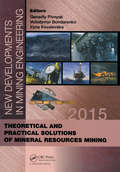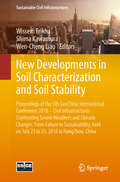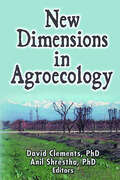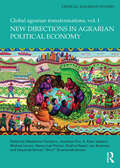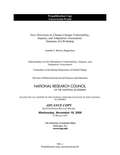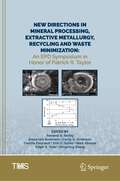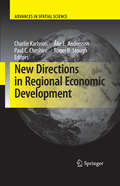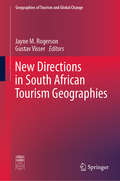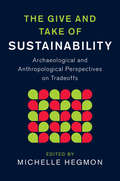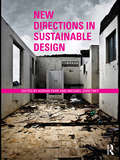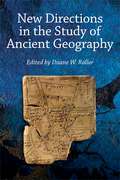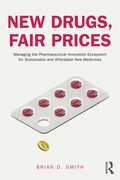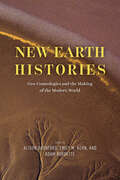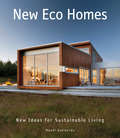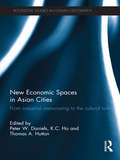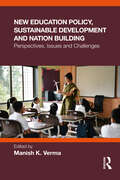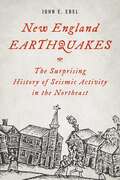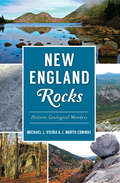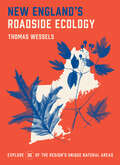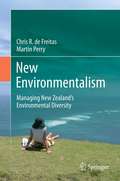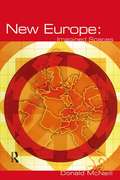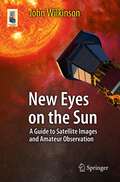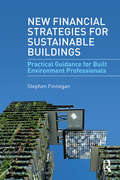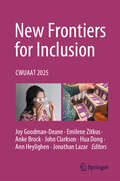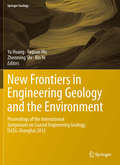- Table View
- List View
New Developments in Mining Engineering 2015: Theoretical and Practical Solutions of Mineral Resources Mining
by Genadiy PivnyakThis annual series of books includes scientific papers on mining profiles. This volume presents multiple aspects of mining technology implementation in several aspects: extraction of coal, iron, manganese, uranium and other ores. Capturing and utilization of coalbed methane by various methods including alternative ones, safety measures in mining, ecological aspects, etc.Specific attention is paid to intensification of mineral resources extraction processes by way of modernizing opening methods, development and mining methods depending on mining-geological conditions. Experimental results of stress-strain state rock massif forecast by means of computational experiments using recursive methods are also discussed. Any mining operations should finally result in adequate recovery of land surface and utilization of mining wastes using various environmentally friendly methods, thus, sufficient attention is paid to this scientific trend. Non-traditional methods of minerals mining are becoming more topical and of higher demand in the modern society. Hence, several papers/chapters are devoted to underground coal gasification and its subsequent processes. In addition, extraction technologies of gas hydrate, as a source of an abundant amount of natural gas, are thoroughly examined in this book, including implementation of gas hydrate technologies for mine methane utilizations with its following transportation in a solid state. Furthermore, attention is given to evaluation of economic efficiency of minerals mining by the proposed methods, their ways of enrichment, ecological aspects and the influence of mining production on the environment, innovational logistic solutions at mining enterprises, and also to perspectives of Ukraine‘s mining industry integration to the European standards.
New Developments in Soil Characterization and Soil Stability: Proceedings of the 5th GeoChina International Conference 2018 – Civil Infrastructures Confronting Severe Weathers and Climate Changes: From Failure to Sustainability, held on July 23 to 25, 2018 in HangZhou, China (Sustainable Civil Infrastructures)
by Wissem Frikha Shima Kawamura Wen-Cheng LiaoThis book presents new studies dealing with the attempts made by the scientists and practitioners to address contemporary issues in geotechnical engineering such as characterization of soil, geomaterials, soil stability and some other geomechanics issues that are becoming quite relevant in today's world. Papers were selected from the 5th GeoChina International Conference on Civil Infrastructures Confronting Severe Weathers and Climate Changes: From Failure to Sustainability, held on July 23-25, 2018 in HangZhou, China.
New Dimensions in Agroecology
by Anil Shrestha David ClementsReduce the environmentally negative aspects of industrial agriculture with an ecologically sound philosophy! New Dimensions in Agroecology explores the latest developments in the emerging science of agroecology, focusing on how these new concepts and cutting-edge tools will help minimize the impact of agriculture on the environment and fos
New Directions in Agrarian Political Economy: Global Agrarian Transformations, Volume 1 (Critical Agrarian Studies)
by Madeleine Fairbairn, Jonathan Fox, S. Ryan Isakson, Michael Levien, Nancy Lee Peluso, Shahra Razavi, Ian Scoones, Kalyanakrishnan “Shivi” SivaramakrishnanHow relevant are the classic theories of agrarian change in the contemporary context? This volume explores this question by focusing upon the defining features of agrarian transformation in the 21st century: the financialization of food and agriculture, the blurring of rural and urban livelihoods through migration and other economic activities, forest transition, climate change, rural indebtedness, the co-evolution of social policy and moral economies, and changing property relations. Combined, the eleven contributions to this collection provide a broad overview of agrarian studies over the past four decades and identify the contemporary frontiers of agrarian political economy. In this path-breaking collection, the authors show how new iterations of long evident processes continue to catch peasants and smallholders in the crosshairs of crises and how many manage to face these challenges, developing new sources and sites of livelihood production.This volume was published as part one of the special double issue celebrating the 40th anniversary of the Journal of Peasant Studies.
New Directions in Climate Change VULNERABILITY, IMPACTS, AND ADAPTATION ASSESSMENT: SUMMARY OF A WORKSHOP
by National Research Council of the National AcademiesWith effective climate change mitigation policies still under development, and with even the most aggressive proposals unable to halt climate change immediately, many decision makers are focusing unprecedented attention on the need for strategies to adapt to climate changes that are now unavoidable. The effects of climate change will touch every corner of the world's economies and societies; adaptation is inevitable. The remaining question is to what extent humans will anticipate and reduce undesired consequences of climate change, or postpone response until after climate change impacts have altered ecological and socioeconomic systems so significantly that opportunities for adaptation become limited. This book summarizes a National Research Council workshop at which presentations and discussion identified specific needs associated with this gap between the demand and supply of scientific information about climate change adaptation.
New Directions in Mineral Processing, Extractive Metallurgy, Recycling and Waste Minimization: An EPD Symposium in Honor of Patrick R. Taylor (The Minerals, Metals & Materials Series)
by Mark Strauss Mingming Zhang Camille Fleuriault Alexandra Anderson Ramana G. Reddy Corby G. Anderson Erik D. Spiller Edgar E. VidalThis collection addresses new research and technology for increased efficiency, energy reduction, and waste minimization in mineral processing, extractive metallurgy, and recycling. Professor Patrick R. Taylor and his students have been studying these topics for the past 45 years. Chapters include new directions in:· Mineral Processing · Hydrometallurgy · Pyrometallurgy · Electrometallurgy · Metals and E waste recycling · Waste minimization (including by-product recovery) · Innovations in metallurgical engineering education and curriculum development
New Directions in Regional Economic Development
by Charlie Karlsson Paul C. Cheshire Ake E. Andersson Roger R. StoughThe emphasis of this book lies on emerging hypotheses, new methods and theoretic developments in the field of regional economic development. A further amplification is provided with a diverse set of cases extending this new way of thinking at the theory and methods level into policy and practice. The case studies range from a focus on Europe, Central and East Asia and North America. Considerable emphasis is laid on the role of entrepreneurship and innovation as drivers of economic growth and development on the sub-national regional level.
New Directions in South African Tourism Geographies (Geographies of Tourism and Global Change)
by Jayne M. Rogerson Gustav VisserThis book provides an overview of innovative and new directions being chartered in South African tourism geographies. Within the context of global change the volume explores different facets and different geographies of tourism. Key themes under scrutiny include the sharing economy, the changing accommodation service sector, touring poverty, tourism and innovation, tourism and climate change, threats to sustainability, inclusive tourism and a number of studies which challenge the present-mindedness of much tourism geographical scholarship. The 18 chapters range across urban and rural landscapes in South Africa with sectoral studies which include adventure tourism, coastal tourism, cruise tourism, nature-based tourism, sports tourism and wine tourism. Finally, the volume raises a number of policy and planning issues in the global South in particular relating to sustainability, local economic development and poverty reduction. Outlining the impact of tourism expansion in South Africa and suggesting future research directions, this stimulating book is a valuable resource for geographers as well as researchers and students in the field of tourism studies.
New Directions in Sustainability and Society: The Give and Take of Sustainability
by Michelle HegmonSustainability strives to meet the needs of the present without compromising the future, but increasingly recognizes the tradeoffs among these many needs. Who benefits? Who bears the burden? How are these difficult decisions made? Are people aware of these hard choices? This timely volume brings the perspectives of ethnography and archaeology to bear on these questions by examining case studies from around the world. Written especially for this volume, the essays by an international team of scholars offer archaeological and ethnographic examples from the southwestern United States, the Maya region of Mexico, Africa, India, and the North Atlantic, among other regions. Collectively, they explore the benefits and consequences of growth and development, the social costs of ecological sustainability, and tensions between food and military security.
New Directions in Sustainable Design
by Adrian Parr Michael ZaretskyRecently there has been a plethora of work published on the topic of sustainability, much of which is purely theoretical or technical in its approach. More often than not these books fail to introduce readers to the larger challenge of what thinking sustainably might entail. Combining a series of well know authors in contemporary philosophy with established practitioners of sustainable design, this book develops a coherent theoretical framework for how theories of sustainability might engage with the growing practice of design. This book: brings together new and emerging perspectives on sustainability provides cohesive and jargon-free reading articulates the specificity of both theory and practice, to develop a symbiotic relationship which allows the reader to understand what thinking sustainably entails This volume describes a variety of new ways to approach sustainable design and it equips the next generation of designers with necessary conceptual tools for thinking sustainably.
New Directions in the Study of Ancient Geography (Publications of the Association of Ancient Historians)
by Duane W. RollerThis volume brings together five essays that represent the latest directions in the study of geography in classical antiquity. Arranged chronologically, these contributions cover several centuries and cultures, ranging from ancient Mesopotamia to the Roman Empire and deal with topics such as ancient cosmology, literary interpretations of geography, ancient navigation, and geography in the Roman Imperial world.Beginning in the ancient Near East, Paul T. Keyser’s essay considers how Greek scholars—whose views on the cosmos are still relevant today—were influenced by early Near Eastern beliefs about the universe. Moving to the Hellenistic period, Duane W. Roller presents and provides commentary on a navigational guide for Ptolemaic seamen written by Ptolemy II’s chief of naval staff, Timosthenes of Rhodes. Georgia L. Irby provides an analysis of a literary map—the Shield of Aeneas from Vergil’s Aeneid—as well as a detailed study of Pomponius Mela and his Chorographia, the earliest surviving Greco-Roman geographical treatise and the only extant independent geographical work in Latin. An essay by Molly Ayn Jones-Lewis completes the volume by describing how Tacitus’s Germania, of the early second century AD, is a work heavily reliant on environmental determinism, an issue that is still relevant today.Together, these essays demonstrate the great diversity of both ancient geographical writing and modern scholarship on ancient geography. This volume will be greeted with enthusiasm by ancient historians and classical studies scholars, particularly those interested in the cultural and political facets of geography.
New Drugs, Fair Prices: Managing the Pharmaceutical Innovation Ecosystem for Sustainable and Affordable New Medicines
by Brian D. SmithNew Drugs, Fair Prices addresses the important question of how we might get the innovative new medicines we need at prices we can afford. Today, this debate is impassioned but sterile. One side calls for price controls, discounting their impact on investment in innovation. The other points to miraculous new therapies, disregarding their affordability and social inequity. This polarized argument creates more heat than light, threatening the social contract between the industry and society on which pharmaceutical innovation depends. This ground-breaking book takes a wholly new perspective on the issue and raises the debate to a more informed and productive level. Drawing on interviews with more than 70 experts across the pharmaceutical innovation world and combining a diverse literature from scientific, political, economic and business domains, it describes how a sustainable and affordable supply of new medicines is possible only by balancing pharmaceutical innovation’s complex, adaptive ecosystem. By considering how each of the ecosystem’s seven habitats work and interact with the others, it makes a comprehensive set of recommendations for achieving that ecosystem balance. The core message of New Drugs, Fair Prices is important to anyone who ever has needed or will ever need a medicine: we can have a sustainable supply of new medicines that are both innovative and affordable if we manage the pharmaceutical innovation ecosystem intelligently.
New Earth Histories: Geo-Cosmologies and the Making of the Modern World
by Dipesh ChakrabartyA kaleidoscopic rethinking of how we come to know the earth. This book brings the history of the geosciences and world cosmologies together, exploring many traditions, including Chinese, Pacific, Islamic, South and Southeast Asian conceptions of the earth’s origin and makeup. Together the chapters ask: How have different ideas about the sacred, animate, and earthly changed modern environmental sciences? How have different world traditions understood human and geological origins? How does the inclusion of multiple cosmologies change the meaning of the Anthropocene and the global climate crisis? By carefully examining these questions, New Earth Histories sets an ambitious agenda for how we think about the earth. The chapters consider debates about the age and structure of the earth, how humans and earth systems interact, and how empire has been conceived in multiple traditions. The methods the authors deploy are diverse—from cultural history and visual and material studies to ethnography, geography, and Indigenous studies—and the effect is to highlight how earth knowledge emerged from historically specific situations. New Earth Histories provides both a framework for studying science at a global scale and fascinating examples to educate as well as inspire future work. Essential reading for students and scholars of earth science history, environmental humanities, history of science and religion, and science and empire.
New Eco Homes
by Manel GutierrezDiscover the latest in eco-friendly home architecture and design.New Eco Homes features twenty-two sustainable homes from around the globe that showcase the newest innovations in environmentally minded home design.<P><P> Inside you'll find the latest design strategies such as various ways to use natural light and ventilation to reduce energy consumption, new methods to integrate home construction into the surrounding landscape, and the numerous recycled and green construction materials that are available today. Specific topics covered include climate regulation, drainage systems, and regional planning. Accompanying each project is a series of colorful photographs, floor plans, and detailed drawings that illustrate sustainable features.This book demonstrates the wide array of ecological and environmental construction solutions that are being applied around the world as a reflection of the growing concern for the environment and energy savings in home building. Whether you're an architect, a designer, or a homeowner looking for new ways to update your home to make it more eco-friendly, this inspiring book is the perfect resource for creating a welcoming and sustainable home.
New Economic Spaces in Asian Cities: From Industrial Restructuring to the Cultural Turn (Routledge Studies in Human Geography)
by Thomas A. Hutton K. C. Ho Peter W. DanielsThe East and Southeast Asia region constitutes the world’s most compelling theatre of accelerated globalization and industrial restructuring. Following a spectacular realization of the ‘industrialization paradigm’ and a period of services-led growth, the early twenty-first century economic landscape among leading Asian states now comprises a burgeoning ‘New Economy’ spectrum of the most advanced industrial trajectories, including finance, the knowledge economy and the ‘new cultural economy’. In an agenda-setting volume, New Economic Spaces in Asian Cities draws on stimulating research conducted by a new generation of urban scholars to generate critical analysis and theoretical insights on the New Economy phenomenon within Asia. New industry formation and the transformation of older economic practices constitute instruments of development, as well as signifiers of larger processes of change, expressed in the reproduction of space in the city. Asia’s major cities become the key staging areas for the New Economy, driven by the growing wealth of an urban middle and professional class, higher education institutions, city-based inter-regional movements and urban mega-projects. New Economic Spaces in Asian Cites animates this New Economy discourse by means of vibrant storylines of instructive cities and sites, including cases studies situated in cities such as Tokyo, Seoul, Shanghai, Beijing, Shenzhen, and Singapore. Theoretical and normative issues associated with the emergence of the new cultural economy are the subject of the book’s context-setting chapters, and each case study presents an evocative narrative of development interdependencies and exemplary outcomes on the ground. New Economic Spaces in Asian Cities offers a vivid contribution to our understanding of the ongoing transformation of Asia’s urban system, including the critical intersections of global and local-regional dynamics in processes of new industry formation and the relayering of space in the Asian metropolis. The synthesis of empirical profiles, normative insights, and theoretical reference points enhances the book’s interest for scholars and students in fields of Asian studies, urban and cultural studies, and urban and economic geography, as well as for policy specialists and urban/community planners.
New Education Policy, Sustainable Development and Nation Building: Perspectives, Issues and Challenges
by Manish K. VermaThe book provides a comprehensive account of the linkages between education, sustainable development, and nation-building from an interdisciplinary perspective. It examines various theories of education and sustainable development and critically explores the origin, evolution, and contours of education in India through the lens of the current policy debates around the Indian educational system. The book also investigates to what extent the New Educational Policy deliberations can be instrumental for the nation’s development, as well as be an effective tool for devising sustainable solutions, including the new challenges posed by climate change.An important blueprint of higher education policy and planning, the book will be indispensable for teachers, students, and researchers of education, public policy, educational studies, development studies, sustainable development, sociology, history, and political studies. It will also be of immense interest to policymakers, development practitioners, and NGOs.
New England Earthquakes: The Surprising History of Seismic Activity in the Northeast
by John E. EbelNew England and nearby areas in the United States and Canada have a long and storied history of earthquakes that goes back to the times of the earliest exploration and settlement of the region by Europeans. This may come as a surprise to the many people living in the region today who have never felt a local earthquake. Nevertheless, not only is it true, but there is every reason to believe that earthquakes, including some damaging earthquakes, will strike New England in the future. In fact, in the 1960s Boston, Massachusetts was given the same seismic hazard rating as Los Angeles, California because both had experienced strong earthquakes in their historic pasts. Since then seismologists have learned much about the rates at which earthquakes occur throughout the country and about the effects of the earthquakes when they occur. Today, we know that the probability of damaging earthquake shaking in Boston is about twenty-five times less than in Los Angeles. Even so, the threat of earthquakes in Boston, throughout New England, and in adjacent regions is one that cannot be ignored. From the 1638 so-called &“Pilgrim&’s Earthquake&” to anticipating what the future may hold, John E. Ebel introduces you to the surprising history of earthquakes in the northeast corridor.
New England Rocks: Historic Geological Wonders (American Heritage)
by J. North Conway Michael J. VieiraNew England is a rocky, rugged region. Its towns are marked by stone walls and its cities anchored by native granite and marble buildings. Historically significant boulders, many with Native American as well as colonial and neo-pagan origins, attract tourists from around the world. Some are formations that are complex in shape, form and significance, while others contain enigmatic messages, meanings and intriguing characteristics. Learn more about the famous sites like Plymouth Rock, the Old Man of the Mountain and the Sleeping Giant, as well as the lesser-known such as Profile Rock, Dighton Rock and Slate Rock. Authors Michael J. Vieira and J. North Conway examine the history, the legends and the people associated with forty-five notable geological wonders.
New England's Roadside Ecology: Explore 30 of the Region's Unique Natural Areas
by Tom WesselsStep Out of Your Car and Right into Nature!New England&’s Roadside Ecology guides you through 30 spectacular natural sites, all within an easy walk from the road. The sites include the forests, wetlands, alpines, dunes, and geologic ecosystems that make up New England. Author Tom Wessels is the perfect guide. Each entry starts with the brief description of the hike's level of difficulty—all are gentle to moderate and cover no more than two miles. Entries also include turn-by-turn directions and clear descriptions of the flora, fauna, and fungi you are likely to encounter along the way. New England&’s Roadside Ecology is a must-have guide for outdoor enthusiasts, hikers, and tourists in Connecticut, Maine, Massachusetts, New Hampshire, Rhode Island, and Vermont.
New Environmentalism
by Chris R. de Freitas Martin PerryThis book explains the role of New Zealand's environmental agencies and regulatory legislation, taking in the impact of international agreements and treaties. It traces the fortunes of sustainable policy approaches and analyzes the activities of the public agencies charged with managing the environment. Moving on to a detailed thematic status report on New Zealand's environment, it examines rural, freshwater, coastal, oceanic, atmospheric and urban zones. Finally, chapters detail public perceptions and normative environmental values as well as the depth of business commitment to environmental responsibility. An ideal introduction to the topic for a diverse range of scholars, the book eschews any specific theoretical framework in charting the recent evolution, current operation and future trajectory of environmentalism in New Zealand. It backs strategic advice with both social and ecological data, and raises questions over the country's reputation for greenness at the same time as recognizing its numerous achievements. With neat summaries of key issues at the end of each chapter, expansive guidance on further reading, and a multitude of examples ideal for classroom debate, this volume gives us an informed, objective, and wide-ranging appraisal on a topic of increasing centrality in the policy debate.
New Europe: Imagined Spaces
by Donald McNeillNew Europe: Imagined Spaces traces the radical transformation of European places and spaces over the last two decades. Instead of the familiar 'schoolbook' map of a Europe of nation-states, the book unpacks the differing imaginations of European identity in recent years. Taking as its central problem the fluid nature of cultural and political identity, it moves firmly away from - and calls into question - the perspective of the nation-state as the primary source of imagined identity for Europeans.The book contributes to key debates, such as the emerging Europe of the Regions and the return of the city-state, examines the 'rebranding' of the nation-state and explores the impact of 'Europeanisation' on existing place identity. Emphasising mobility and movement, the chapters explore borderlands and travel, and also include a detailed discussion of the 'everyday life' of Europeans. Throughout, iconic images of contemporary Europe are invoked: Eurodisney, the Reichstag, Barcelona's Ramblas and the Bilbao Guggenheim, and the way in which mundane artefacts and practices such as football, walking, cars, food, passports and the Euro help construct identity is considered. New Europe: Imagined Spaces adopts a multidisciplinary approach to studying Europe, providing students with an exploration of contemporary European space and place identity.
New Eyes on the Sun
by John WilkinsonInformation collected by satellites recently sent by the USA, the European Space Agency, Japan, Germany, the United Kingdom, and Russia to monitor the Sun has changed our knowledge and understanding of the Sun, particularly its effect on Earth. This book presents these findings in a way that will be welcomed by amateur astronomers, students, educators and anyone interested in the Sun. Enhanced by many colour photographs, the book combines newly acquired scientific understanding with detailed descriptions of features visible on the Sun's surface and in its atmosphere. In the past, observing the Sun has been left to academics with specialised instruments, since solar observation has been unsafe because of the risk of eye damage. This book explains how amateur astronomers can safely observe the various solar phenomena using special hydrogen-alpha telescopes that are not too expensive. Amateurs can now make a positive contribution to science by monitoring the Sun as professionals do. Amateurs can also access the solar images taken by satellites via the internet. This book helps readers interpret and understand what these images are showing about the Sun, including the latest 3D images. Solar observers will enjoy comparing their own solar telescope observations with those produced by space probes such as SDO, SOHO, Hinode and STEREO, and further enjoy learning about transits, eclipses, and space weather and how the Sun compares to other stars in the universe. The main purpose of this book is to present some of the fascinating solar phenomena in their full splendor to readers through a variety of illustrations, photographs and easy to understand text.
New Financial Strategies for Sustainable Buildings: Practical Guidance for Built Environment Professionals
by Stephen FinneganBuilt environment professionals considering whether to embark on the design and construction or retrofit of a fully ‘sustainable’ or ‘green’ build need to know the financial implications of their decisions. What are their financial options? What are the risks? This book offers practical guidance on how sustainable building projects are financed, designed and built. All too often sustainable building is undertaken without proper consideration of the true lifecycle cost, risk and financial impact. This book will take the reader on a journey from initial sustainable design through to final completion highlighting the finance options available to them. New Financial Strategies for Sustainable Buildings provides key guidance to a variety of professionals, including architects, designers, contractors, construction managers, investors and other interested parties, whilst providing a useful reference to students on architecture, construction management and real estate/surveying courses who need to know about finance, construction economics, and sustainable development projects.
New Frontiers for Inclusion: CWUAAT 2025
by John Clarkson Jonathan Lazar Ann Heylighen Hua Dong Joy Goodman-Deane Emilene Zitkus Anke BrockThis book presents papers from the 12th Cambridge Workshop on Universal Access and Assistive Technology (CWUAAT 2025), to be held in April 2025. This workshop series has hosted the multifaceted dialogue on design for inclusion since 2002, involving disciplines including design, computer science, engineering, architecture, ergonomics and human factors, policy and gerontology. The conference theme for 2025 is New frontiers for inclusion. The major themes dealt with in this collection include: Understanding people Designing for an ageing population Designing for particular needs Designing inclusive environments New challenges and opportunities the possibilities and challenges for inclusive design offered by AI and other emerging technologies. With its thematic wealth, this proceedings provides a unique insight into the current national and international research in the fields of inclusive design, universal access, and assistive and rehabilitative technology.
New Frontiers in Engineering Geology and the Environment
by Bin Ye Yu Huang Faquan Wu Zhenming Shi"New Frontiers in Engineering Geology and the Environment" collects selected papers presented at the International Symposium on Coastal Engineering Geology (ISCEG-Shanghai 2012). These papers involve many subjects - such as engineering geology, natural hazards, geoenvironment and geotechnical engineering - with a primary focus on geological engineering problems in coastal regions. The proceedings provide readers with the latest research results and engineering experiences from academic scientists, leading engineers and industry researchers who are interested in coastal engineering geology and the relevant fields. Yu Huang works at the Department of Geotechnical Engineering, Tongji University, China. Faquan Wu works at the Institute of Geology and Geophysics, Chinese Academy of Science, China and he is also the Secretary General of the International Association for Engineering Geology and the Environment. Zhenming Shi works at the Department of Geotechnical Engineering, Tongji University, China. Bin Ye works at the Department of Geotechnical Engineering, Tongji University, China.
